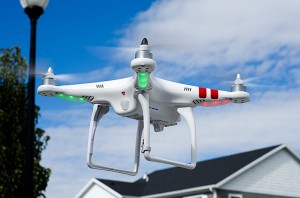

Winter is in full force here with plenty of snow and very cold temperatures. I’ve been working on fine tuning the settings for my large hexacopter (six propeller drone) this year, and when the snow and cold hit I saw that as an opportunity to capture some “winter” themed video and photos for my demo reel. The cold temperatures threw all sorts of monkey wrenches into that idea.
How Cold Temperatures Affect Drones
Drones are highly technical machines with motors, sensors, tight tolerances. The cold temperatures can affect the sensors such as the gyroscope and accelerometers, causing them to misbehave or produce unexpected results. This can affect the flight characteristics of the bird.
Camera gimbals, which are used to keep cameras level or smooth out motion, also have these types of sensors. Cold temperatures can cause gimbals to perform differently than they would in warmer temperatures. One way to try and get around these issues is to calibrate the sensors in the same cold temperatures, not in the warmth of the shop.
Batteries can be greatly affected by the cold. There’s a reason why Sears advertised that their Die Hard car batteries performed in extreme winter conditions, because cold can reduce battery performance. Cold temperatures typically translate to shorter flight times. This is very important to keep in mind for those who time flights rather than keeping an eye on battery voltage. I’ve found that in very cold temperatures the voltage drops quickly at first, but does level out a bit toward the end of the flight.
Brittle parts can be a problem. If there are parts of the drone which need to be tightened before flight, doing so in the cold could result in easy breakage. For instance, the arms on my hexacopter are foldable. I make sure they’re tightened down in the warmth of my house and that I don’t tighten them down outside in the cold. Hard landings in the cold with more brittle parts could mean more damage to the bird in a crash.
Lastly, the pilot can be greatly affected by the cold. While flying yesterday in 12 degree fahrenheit temperatures, my bare fingers were numb about five minutes into the first battery set. Numb fingers can be a very bad thing when the feel of the controls on the remote is so important. With a numb thumb I could easily bump the throttle down and not feel that I’ve done so. A bad bump could mean reducing thrust enough that the bird falls from the sky, or perhaps a bump up in throttle might turn the bird into a kamikaze.
Air Density
Cold temperatures mean higher air density. This can change the flight characteristics of the drone. With higher air density the same propellor RPMs produces more lift. The motors will not have to work as hard, which could be a positive or a negative depending on the setup. Usually it is a positive though, producing slightly smoother flight and working the setup a little less.
It was bound to happen, or was it? I had a small crash yesterday with my big hexacopter. I was attempting to take off and the bird flipped over onto its top. Normally a flip like that indicates propellers on wrong, or motors wired wrong but I haven’t changed anything in the over 100 previous flights.
The bird sustained some minor damage:
I’m going to do a deep inspection and check all screws, levels, mounts, and such before going airborne again.
Causes for RC Multi-rotor Copter Flip
The copter flipped over from left to right, meaning the left side launched faster than the right. I have noticed a couple of takeoffs where the right side seemed to lag a big, requiring me to give it more thrust. Perhaps this time around I was too aggressive with the takeoff and the flight controller was not able to respond quickly enough.
I theorize it is possible that my motors need recalibration. I think perhaps the motors on the left side are calibrated to a higher thrust rate than the right side and this image may support that a bit. The image below is a props-off test of zero to full throttle over about 10 seconds.
Other Theories
One suggested theory is solar flares. Yes that sounds crazy, but solar flares have been happening quite a bit lately and they can cause GPS devices to malfunction or produce bad readings.
Another suggestion is that the GPS was having other issues and not locked on the proper location. If this is the case, the copter may try to move to the position it thinks it “should” be in before the takeoff is complete.
If the cause of the flip is either of the “other theories” above, launching the craft in attitude mode (GPS turned off) is the recommendation. Shortly after takeoff GPS mode can be enabled.
Conclusion – Work to Do
Whether or not the cause of the flip was the difference in throttle shown in the graph above, my first move will be recalibrating the motors and throttle with each other. With motors 1 and 4 above being different at the top end by as much as 14 points on this graph, that’s probably not good.
I’ll need to fix the GPS tower somehow, or mount the GPS again on a battery holder. I can order another tower, but they come from China, so it will take a while. I want/need to fly long before it will arrive. They’re cheap, so I’ll probably just order two more.
I’ll need to inspect the frame, motors, and rest of the copter to make sure there was no other damage. A cracked arm or frame part could be a disaster if it gave way in the air.
Once I feel I’m ready to fly it, a simple takeoff and hover test will be first. Nothing crazy.
 This is geeky beyond measure….
This is geeky beyond measure….
I’m in the “laboratory” getting ready for an aerial shoot tomorrow. My hexacopter is good to go, but in case I need another flight or backup I was getting my DJI Phantom ready to fly. I had just balanced some new props and was walking up the stairs when the doorbell rang. Quad in hand, I answered the door. It was a neighbor kid.
“My rocket is on your roof.”
He had launched a rocket from his yard and miscalculated the wind. The parachute was hanging off the edge of the roof and the rocket was on the roof. I told him I’d be happy to try taking the Phantom up there and seeing if I could get close enough for the wind from the props to blow the rocket down. He, his father, and three other neighbor kids thought that was a brilliant idea.
I was a little worried. I just spent a bunch of money on new props. I’d hate to break them AND leave the damn Phantom on the roof.
I piloted up to the roof and positioned the quad above the rocket. It was a bit breezy so I had to manipulate it a bit to keep it in position, despite being in GPS mode (that’s another discussion). I lowered to the point where the prop wash hit the rocket and voila! The rocket blew down and I was the hero of the neighborhood.
The neighbor kids raved how cool the Phantom was to which I said, “you should see the BIG bird!”
I then busted out the big hexacopter and did a neighborhood flight with a very attentive audience. They loved it, and I got a test flight in on the big bird after having to reset the gimbal settings.